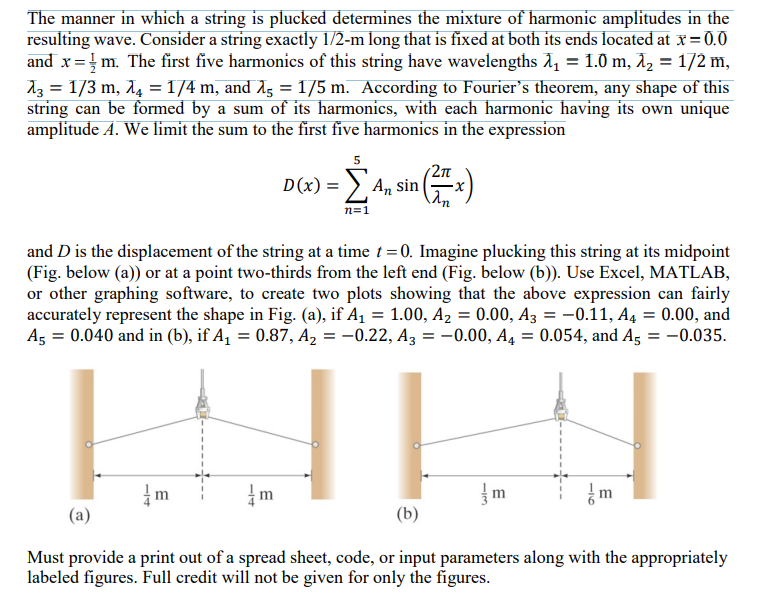The manner in which a string is plucked determines the mixture of harmonic amplitudes in the resulting wave. Consider a string exactly 1/2-m long that is fixed at both its ends located at x = 0.0 and x = m. The first five harmonics of this string have wavelengths λ₁ = 1.0 m, λ₂ = 1/2 m, λ = 1/3 m, 14 = 1/4 m, and λ5 = 1/5 m. According to Fourier's theorem, any shape of this string can be formed by a sum of its harmonics, with each harmonic having its own unique amplitude A. We limit the sum to the first five harmonics in the expression m D(x) = m An sin A, (²x) n=1 and D is the displacement of the string at a time t = 0. Imagine plucking this string at its midpoint (Fig. below (a)) or at a point two-thirds from the left end (Fig. below (b)). Use Excel, MATLAB, or other graphing software, to create two plots showing that the above expression can fairly accurately represent the shape in Fig. (a), if A₁ = 1.00, A₂ = 0.00, A3 = -0.11, A4 = 0.00, and A5 = 0.040 and in (b), if A₁ = 0.87, A₂ = -0.22, A3 = -0.00, A4 = 0.054, and A5 = -0.035. ¹ m 211 m (a) (b) Must provide a print out of a spread sheet, code, or input parameters along with the appropriately labeled figures. Full credit will not be given for only the figures.
The manner in which a string is plucked determines the mixture of harmonic amplitudes in the resulting wave. Consider a string exactly 1/2-m long that is fixed at both its ends located at x = 0.0 and x = m. The first five harmonics of this string have wavelengths λ₁ = 1.0 m, λ₂ = 1/2 m, λ = 1/3 m, 14 = 1/4 m, and λ5 = 1/5 m. According to Fourier's theorem, any shape of this string can be formed by a sum of its harmonics, with each harmonic having its own unique amplitude A. We limit the sum to the first five harmonics in the expression m D(x) = m An sin A, (²x) n=1 and D is the displacement of the string at a time t = 0. Imagine plucking this string at its midpoint (Fig. below (a)) or at a point two-thirds from the left end (Fig. below (b)). Use Excel, MATLAB, or other graphing software, to create two plots showing that the above expression can fairly accurately represent the shape in Fig. (a), if A₁ = 1.00, A₂ = 0.00, A3 = -0.11, A4 = 0.00, and A5 = 0.040 and in (b), if A₁ = 0.87, A₂ = -0.22, A3 = -0.00, A4 = 0.054, and A5 = -0.035. ¹ m 211 m (a) (b) Must provide a print out of a spread sheet, code, or input parameters along with the appropriately labeled figures. Full credit will not be given for only the figures.
Trigonometry (MindTap Course List)
10th Edition
ISBN:9781337278461
Author:Ron Larson
Publisher:Ron Larson
Chapter3: Additional Topics In Trigonometry
Section: Chapter Questions
Problem 41CT
Related questions
Question

Transcribed Image Text:The manner in which a string is plucked determines the mixture of harmonic amplitudes in the
resulting wave. Consider a string exactly 1/2-m long that is fixed at both its ends located at x = 0.0
and x = m. The first five harmonics of this string have wavelengths λ₁ = 1.0 m, λ₂ = 1/2 m,
λ = 1/3 m, 14 = 1/4 m, and λ5 = 1/5 m. According to Fourier's theorem, any shape of this
string can be formed by a sum of its harmonics, with each harmonic having its own unique
amplitude A. We limit the sum to the first five harmonics in the expression
m
D(x) =
m
An sin
A,
(²x)
n=1
and D is the displacement of the string at a time t = 0. Imagine plucking this string at its midpoint
(Fig. below (a)) or at a point two-thirds from the left end (Fig. below (b)). Use Excel, MATLAB,
or other graphing software, to create two plots showing that the above expression can fairly
accurately represent the shape in Fig. (a), if A₁ = 1.00, A₂ = 0.00, A3 = -0.11, A4 = 0.00, and
A5 = 0.040 and in (b), if A₁ = 0.87, A₂ = -0.22, A3 = -0.00, A4 = 0.054, and A5 = -0.035.
¹
m
211
m
(a)
(b)
Must provide a print out of a spread sheet, code, or input parameters along with the appropriately
labeled figures. Full credit will not be given for only the figures.
Expert Solution
This question has been solved!
Explore an expertly crafted, step-by-step solution for a thorough understanding of key concepts.
Step by step
Solved in 2 steps with 2 images

Recommended textbooks for you

Trigonometry (MindTap Course List)
Trigonometry
ISBN:
9781337278461
Author:
Ron Larson
Publisher:
Cengage Learning

Algebra & Trigonometry with Analytic Geometry
Algebra
ISBN:
9781133382119
Author:
Swokowski
Publisher:
Cengage

Trigonometry (MindTap Course List)
Trigonometry
ISBN:
9781337278461
Author:
Ron Larson
Publisher:
Cengage Learning

Algebra & Trigonometry with Analytic Geometry
Algebra
ISBN:
9781133382119
Author:
Swokowski
Publisher:
Cengage